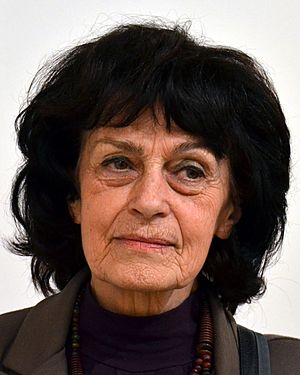Adéla Matasová facts for kids
Quick facts for kids
Adéla Matasová
|
|
|---|---|
 |
|
| Born | 26 July 1940 Prague, Czech Republic
|
| Occupation | Sculptor, Professor at the Art Institute |
Adéla Matasová (born July 26, 1940, in Prague) is a famous Czech artist. She creates amazing sculptures and multimedia art, which often combine different materials and even sound! She has also been a professor, teaching art to many students.
Contents
Adéla Matasová: An Artist's Journey
Early Life and Education
Adéla Matasová started her art journey early. From 1954 to 1958, she went to a special art school in Prague for interior design. After that, in 1958, she began studying monumental painting at the Academy of Fine Arts in Prague. She finished her studies in 1964. In 1968, she even received a special grant from UNESCO to spend two months studying art in Paris, France.
Exploring New Materials
By the late 1960s, Adéla became very interested in sculpture and reliefs. She started using a new material called synthetic resin for her artworks. She showed these pieces at her first solo exhibition in Prague in 1970.
From Resin to Paper
In 1974, she was asked to create a special art show in České Budějovice, which featured music by E. Varèse. Later, in the late 1970s, Adéla discovered a new and exciting material: raw paper pulp. She made paper reliefs and added pencil drawings to them. These unique artworks won an award at the Biennial of Drawing in Rijeka in 1982.
Since 1985, she has been using unprocessed flax paper pulp for her sculptures. These artworks often hang freely in space.
Art That Moves and Sounds
Adéla was very interested in how art could move. This led her to create her first kinetic objects (artworks that move). She showed these moving sculptures at an exhibition in Prague in 1986. That same year, her art was shown at Art Basel in Switzerland. Her work also traveled to the CIAE Chicago in 1987 and the Czech Art Festival in New York City in 1994.
Over time, her art began to include sound. She created sound installations, which are artworks that use sound to define a space. These were shown in various cities like Prague, Ústí nad Labem, Klatovy, and Brno.
Her newer works often mix metal plates with rods or use shiny steel mirrors. In 1993, she participated in art symposiums in Crete, Greece, and Filakovo, Slovakia.
Her artworks can be found in important places like the National Gallery in Prague and other galleries in the Czech Republic and abroad. Many private collectors in Germany, the United States, Sweden, and Poland also own her pieces.
Teaching and Exhibitions
In 1990, Adéla Matasová became a professor at the Academy of Applied Arts in Prague. She taught there until 2003. She also spent a year (2000) as a visiting professor at the University of Colorado, Boulder in the U.S. From 2004 to 2005, she was a leader in art education at the Literary Academy of Josef Škvorecký in Prague. Currently, she is a professor at the Institute of Art and Design in Pilsen.
She continues to live and work in Prague, Czech Republic.
Selected Works
Here are some of Adéla Matasová's notable artworks:
- Talk to me, Museum Kampa, Prague (2008)
- The kinetic object "Illumination" (350×350 cm), Star Summer house hall, Prague (2005)
- Interspaces, Gallery Montanelli, Prague, (2005) – these were kinetic objects
- Fictitious projects, Špála gallery, Prague (2001) – included kinetic objects and manipulated computer photography
- Kinetic objects, Mánes, Prague (2000) – used elastic membranes
- Rain wall, Klenová castle, Work of Art in the Public Space (1998) – made of steel
- Rain Wall II, Socrates Sculpture Park, New York City (1997) – made of steel. A permanent installation (7 meters tall) is at the Pratt Institute, Brooklyn, New York.
- Mangers and tombs, Via Art Gallery, Prague (1995) – made of steel, straw, and light
- Changing places, The World Financial Center, New York City (1994) – made of steel and aluminum rods
- Communication III, Old Town Hall Brno, Municipal Gallery, Brno (1993) – used steel, mirror steel, and sound
- Communication II, Agios Nikolaos, Crete (1993) – used steel and mirror steel
- Inhabited landscape, Klenová castle, (1989) – made of steel, mirror steel, and wood
- Situation II, New hall, Brno (1990) – used flax mass, wood, and rope
- Situation I, UKDZ Prague (1989) – used flax mass, wood, and rope

